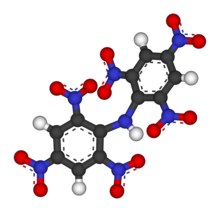Hexanitrodiphenylamine (abbreviated HND), is an explosive chemical compound with the formula C12H5N7O12. Since it is made from readily available raw materials, HND was used extensively by the Japanese and less extensively by Nazi Germany during World War II but was discontinued due to its toxicity.

| |

| |
| Names | |
|---|---|
| Preferred IUPAC name
2,4,6-Trinitro-N-(2,4,6-trinitrophenyl)aniline | |
| Other names
bis(2,4,6-Trinitrophenyl)amine
HNDA HNDPA Dipicrylamine Hexamine Hexil Hexyl Hexite Hexamin | |
| Identifiers | |
3D model (JSmol)
|
|
| ChemSpider | |
| ECHA InfoCard | 100.004.581 |
| EC Number |
|
PubChem CID
|
|
| UNII | |
CompTox Dashboard (EPA)
|
|
| |
| |
| Properties | |
| C12H5N7O12 | |
| Molar mass | 439.209 g·mol−1 |
| Appearance | Crystalline solid. Yellow to orange. As ordinarily manufactured, it is yellow brown. |
| Density | 1.64 g/cm3 (pressed) |
| Melting point | 243 to 245 °C; 469 to 473 °F; 516 to 518 K with decomposition |
| Soluble in acetone, warm glacial acetic acid, nitric acid, or aqueous alkalies except potassium hydroxide. | |
| Explosive data | |
| Detonation velocity | 7100 m/s |
Except where otherwise noted, data are given for materials in their standard state (at 25 °C [77 °F], 100 kPa).
| |
Preparation
editDinitrodiphenylamine is treated with 98% nitric acid. The starting material, dinitrodiphenylamine, is obtained from the reaction of aniline, dinitrochlorobenzene, and soda ash.
Applications
editHND is a booster-class explosive that was used in World War II by the Germans as a component of Hexanite (60% TNT - 40% HND) and by the Japanese as a component of Kongo (Type 98 H2) (60% Trinitroanisole - 40% HND) for use in bombs, sea mines and depth charges; Seigate (Type 97 H) (60% TNT - 40% HND) for use in torpedo warheads and depth charges; and also in Otsu-B (60% TNT, 24% HND & 16% aluminium powder) for use in torpedo warheads.
Its ammonium salt, also known as Aurantia or Imperial Yellow, was discovered in 1873 by Emil Kopp and used as a yellow colorant for leather, wool and silk in the 19th and early 20th centuries.[1]
Safety and toxicity
editA most toxic and poisonous explosive, it attacks the skin, causing blisters which resemble burns. Dust from HND is injurious to the mucous membranes of the mouth, nose, and lungs. Several nitroaromatic explosives, including HND, have been found to be mutagens.[2]
Incidents
editOn 12 May 2022, construction of the Bundesautobahn 49 in Germany was halted, after traces of the explosive were found in the excavated material. The road passes over a former explosives factory near Stadtallendorf. The factory had been demolished after World War II, and it was not expected that traces of explosives had remained in the ground.[3]
See also
editReferences
edit- TM 9-1985-4 Japanese Explosive Ordnance (Bombs, Bomb fuzes, Land mines, Grenades, Firing Devices and Sabotage Devices). Departments of the Army and Air Force. March 1953.
- TM 9-1985-5 Japanese Explosive Ordnance (Army Ammunition, Navy Ammunition). Departments of the Army and Air Force. March 1953.
- Japanese Explosives (USNTMJ-200E-0551-0578 Report 0-25) (Report). U.S. Naval Technical Mission to Japan. December 1945.
- ^ Science & Society Picture Library: Synthetic colorant, c 1900
- ^ PubChem. "2,4,6-Trinitroanisole - Non-Human Toxicity Excerpts". pubchem.ncbi.nlm.nih.gov. Retrieved 2019-09-14.
- ^ ""Hexyl" im Erdaushub: Sprengstoff-Stopp an A49-Baustelle". hessenschau.de (in German). 13 May 2022. Archived from the original on 13 May 2022. Retrieved 13 May 2022.